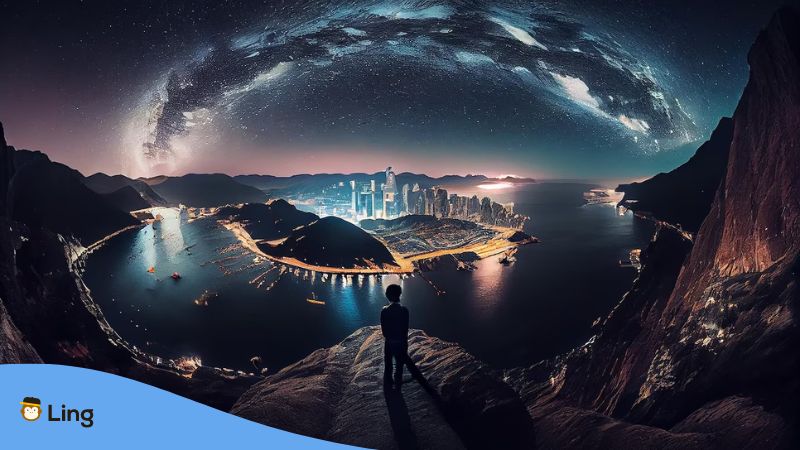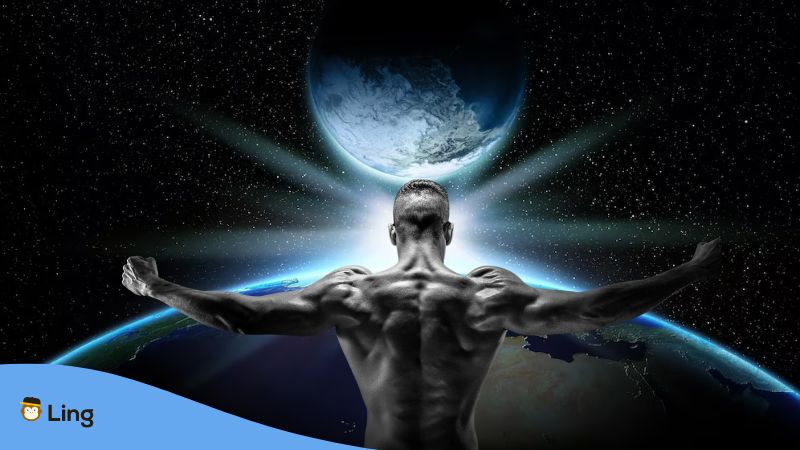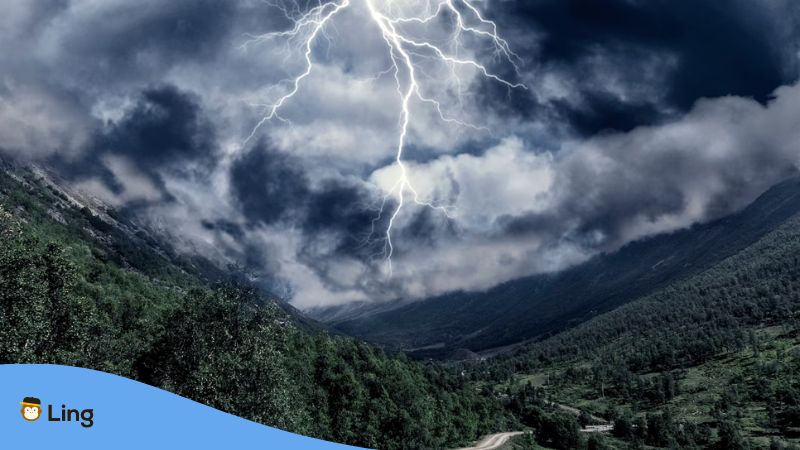Have you ever heard the name Pan Gu? It’s a name that rings through the annals of classical Chinese mythology, a giant born out of pure chaos whose actions formed our world.
His story, echoing from the lips of ancient storytellers, is a tapestry woven from threads of chaos and order.
The Pan Gu myth, a cornerstone of Chinese cultural heritage, offers a window into the beliefs and philosophies that shaped ancient China.
Now, let’s take a moment to appreciate this: “天地混沌如雞子” (tin1 dei6 wan4 deon6 jyu4 gai1 zi2).
In the Cantonese language, this phrase translates to “the universe was a chaotic egg,” a vivid image of the cosmos before Pan Gu’s emergence.
Just a few words, and yet they paint such a vibrant picture. This blend of language and mythology is truly mesmerizing.
As we peel back the layers of the Chinese creation myth, we’ll uncover a rich tapestry of cultural values, philosophical concepts, and linguistic gems.
Understanding Creation And Cosmogonic Myths
Ever wonder why we have so many stories about how the world began? Let’s unravel that mystery.
What Are Creation And Cosmogonic Myths
So, what’s a creation myth? It’s a story about the birth of the universe.
It’s like a grand unveiling, a cosmic “ta-da” moment.
On the other hand, a cosmogonic myth is a particular type of creation story.
It focuses on the genesis of the cosmos.
It’s all about how order came from chaos. Think of it as the “origin story” of all things.
Ever heard of the Cantonese phrase “萬物的起源” (maan6 mat6 dik1 hei2 jyun4)? It directly translates to “the origin of all things.”
Role Of Myths In Shaping Societal And Cultural Beliefs
So why do these myths matter? Simple. They shape our beliefs.
They mold our cultural values.
These stories passed down through generations are more than just tales.
They’re the fabric of societies.
Take Chinese society, for instance.
The Pan Gu myth has deeply influenced its philosophy and worldview.
It’s not just a story, but a lesson in balance, harmony, and the circle of life.
In essence, creation myths are like societal compasses.
They guide cultures, steer philosophies, and provide a sense of identity.
Intriguing? Let’s start unveiling the Chinese creation mythology.

1. The Stage Of Chaos: Before Pan Gu’s Emergence
Before we delve into the world of Pan Gu, we must first grasp the state of the universe that existed before his arrival.
It was a time of disorder, a stage of pure chaos.
The Huge Egg Containing Chaos
Envision an enormous egg, but not the kind you’d crack open for breakfast.
This was a “混沌的大蛋” (wan4 deon6 dik1 daai6 daan2), a chaotic great egg filled with a whirlpool of elements.
It was an enigmatic entity, swirling with unformed matter, colors intertwining in an erratic dance.
It was a realm of unpredictability, a place of potential, waiting for the catalyst to bring order.
State Of The Universe Before Pan Gu’s Arrival
And what was this universe like before Pan Gu appeared on the scene?
It was a world devoid of structure, a realm where chaos reigned supreme.
Without the sky, without Earth, it was an unformed void, a canvas awaiting the brushstrokes of creation.
2. Pan Gu: The Giant From The Chaos
Now, let’s turn the page to the next chapter of our cosmic tale.
Introducing the protagonist of our narrative – Pan Gu.
Pan Gu’s Birth From The Chaotic Egg
In a moment of cosmic significance, Pan Gu emerged. “盤古破壳” (pun4 gu2 po3 hok3), or “Pan Gu breaking the shell,” as the Cantonese phrase goes.
From the heart of the chaotic egg, Pan Gu burst forth, a sign that the time of order was about to commence.
It was a spectacular entrance, a dramatic beginning to a tale of creation.
Initial Growth And Development Of Pan Gu
Once Pan Gu was born, the universe began to shift.
Born as a giant, Pan Gu grew daily, not just in size but in wisdom.
His presence filled the void, his growth mirrored by the universe’s expansion.
Just imagine a giant maturing and learning, his journey of growth shaping the cosmos around him.

3. Separating The Heavens And The Earth
Let’s go deeper into our Chinese creation myth. Let’s examine how Pan Gu stood and embarked on one of his greatest tasks.
How Pan Gu Separated Heaven And Earth
Pan Gu, our heroic giant, took on an immense task.
He pushed against the swirling chaos, laboring to separate the Yin from the Yang.
In Cantonese, we say “盤古開天地” (pun4 gu2 hoi1 tin1 dei6), which translates to “Pan Gu opens the heavens and the earth.”
Over many years, the heavens rose, the Earth fell, and space expanded between them.
And so, the world as human beings know it began to take shape.
The Symbolism Behind This Action In Chinese Culture
This epic act of Pan Gu isn’t just a tale of physical creation.
It’s brimming with symbolism deeply ingrained in Chinese and Hong Kong culture.
Separating heaven and Earth mirrors the fundamental principle of dualism, the harmony of Yin and Yang.
It’s a constant reminder that balance is intrinsic to the order of the universe.
4. Pan Gu’s Sacrifice: Death And Rebirth As The World
But every story has its climax. And for Pan Gu? It was his ultimate sacrifice.
The Death Of Pan Gu
After achieving the monumental task of separating the heavens and the Earth, Pan Gu found himself at the end of his journey.
His strength depleted, his energy spent, he settled into a final, deep rest.
In Cantonese, we might say “盤古死亡” (pun4 gu2 sei2 mong4), which simply means “Pan Gu’s death.”
It was a moment of profound silence, marking the end of Pan Gu’s conscious life.
But as we’ll see, it was far from the end of his influence on the world.
Yes, Pan Gu died. But, as it turns out, it was only the beginning.
Pan Gu’s Body Transformed Into Various Elements Of The World
In death, Pan Gu gave birth to the world.
His body, once a living entity, transformed into the various elements of our world.
The phrase “盤古化身為世界” (pun4 gu2 faa3 san1 wai4 sai3 gaai3) captures this transformation. It translates to “Pan Gu transforms into the world.”
His breath became the clouds and wind, his voice the rolling thunder.
His eyes turned into the sun and moon.
His body into mountains, and his blood into rivers.
The transformation was profound, a final act of creation that gave rise to the world we inhabit.

5. Echoes Of Pan Gu: From Rolling Thunder To Mountain Peaks
As we follow the echoes of Pan Gu’s existence, we see him not only in the world’s creation but also in its many natural wonders.
Pan Gu’s Voice, Breath, And Body Parts
Pan Gu’s end was not a simple cessation of life.
Instead, it was a magnificent transformation to form Earth.
His mighty voice turned into the booming thunder, and his breath morphed into the gentle breeze and gusty winds.
Remember when we mentioned “盤古化身為世界” (pun4 gu2 faa3 san1 wai4 sai3 gaai3)?
His body didn’t just lie there; it shaped the very landmarks we see today.
His limbs became towering mountains, and his blood flowed into rivers.
The sweat from his skin is like a rain of sweet dew nurturing all living things.
Pan Gu is all around us, his essence woven into the fabric of the natural world.
The Cultural Significance Of These Transformations
These transformations are far from mere tales.
They hold deep cultural significance.
They convey the belief that the natural world is a living entity intertwined with the divine.
To the Chinese, nature is not separate from us but a part of us.
Pan Gu’s tale reminds us of our interconnectedness with the world.
The Yin And Yang Concepts, And Their Presence In The Myth
Central to the Pan Gu myth is the concept of Yin and Yang.
It’s a philosophy deeply rooted in Chinese and Cantonese people’s thoughts.
In the myth, Pan Gu separates the heavy Yin and the light Yang, creating a balance.
It’s a testament to the idea that opposing forces can coexist and are necessary for harmony.
In Cantonese, we say “陰陽” (jam1 joeng4) for Yin and Yang.
The symmetry of Yin and Yang is a recurring theme in Chinese culture and philosophy, reminding us of the need for balance in our lives.
Chinese Creation Myth Vocabulary
Ever thought about how language and culture are intertwined, especially regarding myths and legends?
Well, here’s a thought: to truly immerse in the tale of Pan Gu and other myths, it helps to get acquainted with the lingo. That’s right! The Cantonese words bring this story to life.
Isn’t it interesting how a simple word can carry so much weight, so much history?
With these words in your arsenal, you’re well on your way to exploring Chinese creation myths in their original flavor.
So, what’s next? Are you ready to spin a tale of Pan Gu in Cantonese?
Learn About The Chinese Creation Myth With Ling!
Here’s a nugget to ponder: every word, every phrase we’ve just explored, adds a new layer to the rich tapestry of the Chinese creation myth.
It’s more than just a story. It’s a journey through time, culture, and language.
But why stop here?
With the Ling app, you can journey through not just the Cantonese language but over 60 different languages.
It’s your portal to explore languages from all over the world, all in one place.
Whether you’re keen on brushing up your vocabulary or venturing into a new language, we’ve got you covered.
Download the Ling app today from Google Play or the App Store now!























